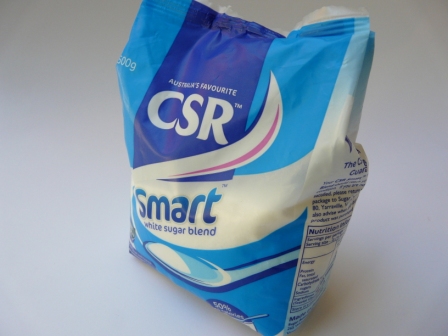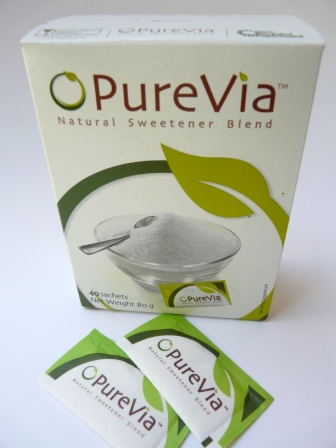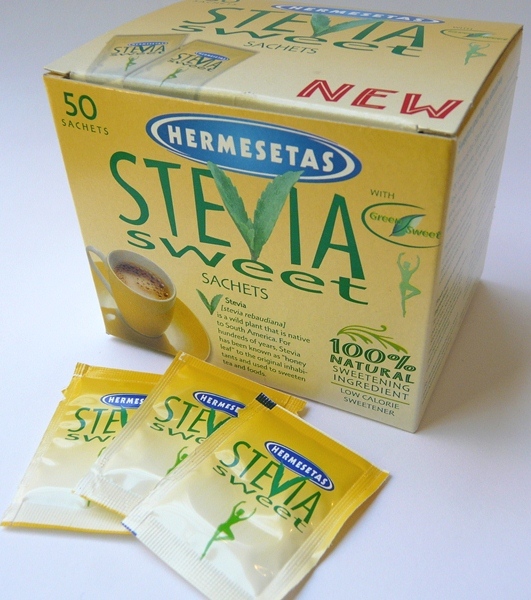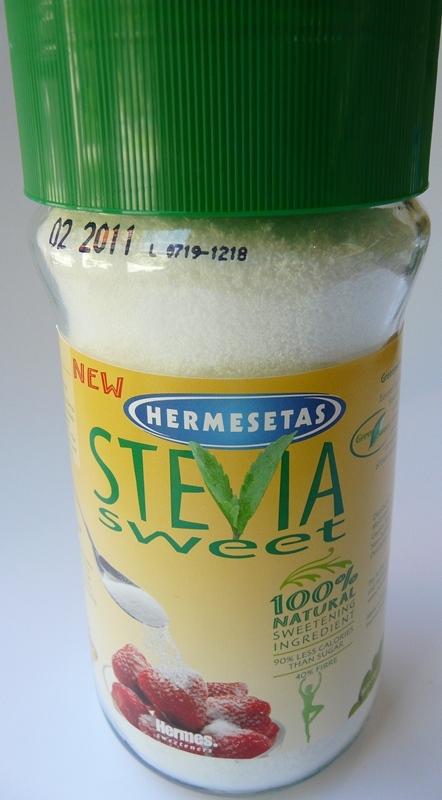Product review: Stevia sweeteners side by side

A "natural" sweetener, Stevia was approved for use in 2008 in Australia and the US and the first Stevia products are now appearing on the supermarket shelves.
It's not considered "artificial" and marketing for stevia makes much of it being 100% natural - which appeals to consumers - compared to aspartame or acesulfame-K which are often regarded as "chemical" and can't escape the cancer-scare rumours that have been circulating for years.
Background on stevia
Stevia (stee-vee-ah) is derived from the leaves of a sweet plant native to Paraguay in South America. It's 250 to 300 times sweeter than sugar gram for gram but supplies no kilojoules (Calories) and does not raise blood sugar.
Glycosides are the active compounds in Stevia that give it its sweet flavour. However there is a slight aftertaste which I pick up and dislike - some people notice and dislike while others don't mind it. To me, it's not the same as sugar but IS way better in taste than the older sweeteners such as saccharin or even aspartame.
Stevia - test-driving the products ...
Sweetener No 1: CSR SmartTM White Sugar Blend
 This looks like a regular white sugar but has a tiny addition of stevia powder - only 0.4% steviol glycosides plus 99.6% sugar. Smart™ is twice as sweet as ordinary sugar so you only need to use half as much.
This looks like a regular white sugar but has a tiny addition of stevia powder - only 0.4% steviol glycosides plus 99.6% sugar. Smart™ is twice as sweet as ordinary sugar so you only need to use half as much.
Manufacturer
CSR who market most of the sugar in Australia
Taste 7/10
Relative to ordinary sugar. You still get an after-taste in the back of your mouth as you swallow. It's slightly liquorice overtone is not unpleasant but is noticable. I sneaked half a teaspoon into my husband's tea without him knowing and he picked it straight away.
Nutrition 7/10
7/10 as it helps dieters to cut their sugar intake by half.
Half a teaspoon (2 g) has only 34 kJ / 8 Cals compared to 65 kJ / 15 Cals for a teaspoon of sugar.
Ingredients
Sugar 99.6%, sweetener (steviol glycosides 0.4%)
On-pack claims
- "Better for you"
- "Contains natural ingredients"
- "50% less Calories - twice as sweet so you use half as much"
Convenience 10/10
It looks and tastes exactly like white sugar. You simply use half the quantity you normally use for the same sweetness. Bear in mind that it's expensive - prepare to pay $2 for a 500 g pack (which is 40c per 100 g) compared with $1.20 for 500 g sugar (24c per 100 g).
Sweetener No 2: PureViaTM stevia sachets
 These look like the little sachets of Equal® that you spot at cafes as a dieter's alternative to sugar.
These look like the little sachets of Equal® that you spot at cafes as a dieter's alternative to sugar.
Manufacturer
Whole Earth Sweetener company, a subsidiary of Merisant who also manufacturer Equal®.
Taste 6/10
Not as ‘clean' a taste as CSR Smart. On a par with Equal®.
Nutrition 8/10
One sachet (2 g) gives you 13 kJ (3 Cals) but is equivalent in sweetness to two level teaspoons of sugar at 140 kJ (33 Cals). It's not pure Stevia - it's a blend of three sweeteners (erythritol, isomaltulose and steviol glycosides), along with flavours plus a cellulose powder bulking agent. The amount of Stevia is so small, it needs the cellulose to make it manageable.
On-pack claims
- "PureViaTM, the natural sweetener blend with 90% less kilojoules than sugar, made with the pure, sweet extracts of the Stevia plant. We blend these extracts, known as Steviol Glycosides, with other carefully selected ingredients to give you the smooth, sweet taste of PureVia™."
Convenience 8 /10
One PureVia™ sachet (13 kJ or 3 Cals) is equivalent in sweetness to two level teaspoons of sugar (140 kJ). For some strange reason, one sachet is equivalent to two teaspoons of sugar which is fine if that's the amount you normally add to your coffee or tea but you end up wasting half the sachet if you only want one teaspoon. For dieters, I wouldn't want them getting used to two teaspoons of sugar per cup.
Sweetener No 3: Hermesetas SteviaSweetTM
 This comes in three forms - granulated for use in cooking and baking as well as sachets and tablets for coffee and tea.
This comes in three forms - granulated for use in cooking and baking as well as sachets and tablets for coffee and tea.
Manufacturer
Hermesetas who also manufacture sweeteners (saccharin years ago, later aspartame) in tablet and sachet form for many years.
Taste 7/10
Relative to sugar
Nutrition 8/10
The granules are a blend of a starch carrier maltodextrin (53%) together with fructofibres (inulin 34% plus oligofructose 8%) for fibre and the base sweetener steviol glycosides (5%), So it's high in soluble fibres and prebiotic which stimulate the growth of friendly bacteria in the bowel.
On-pack claims
- "100% natural sweetening ingredient"
- "90% less calories than sugar"
- "40% fibre"
- "Suitable for cooking and baking"
- "Low Carb / low GI"
Convenience 10/10
The granules are versatile for sweeteneing fruit and desserts as well as coffee and tea. Use cup for cup to replace sugar, so 1 cup sugar = 1 cup SteviaSweet™. The weight is one-tenth the weigh of sugar, so 50 g sugar = 5 g Steviasweet™.
Related information
- Read my review of LowGIcane sugar in the Foodwatch Reviews section and see whether it would suit you instead of these stevia sweeteners.
-
Want to cut back on your sugar intake? Download my handy Fact Sheet on sugar - where it's hiding, how much is in the everyday foods we love to eat, how much is OK to have, and 4 easy ways to eat less.







